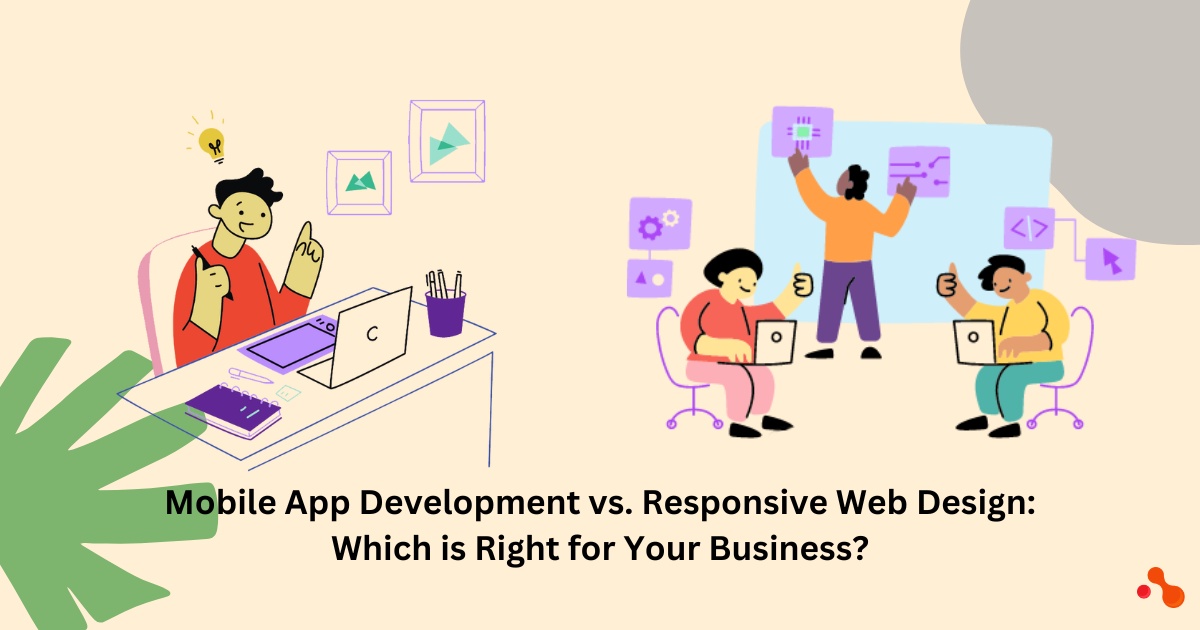Introduction
Choosing the right digital solution for your business can be a challenging task. Mobile app development and responsive web design are two popular options in today's technology-driven world. But which one is best suited for your business? This blog will explore the key differences between mobile app development and responsive web design, helping you make an informed decision. Whether you're considering hiring a mobile app development company or exploring options for responsive web design, this article will provide valuable insights for your business's digital journey.
Understanding Mobile App Development
- Definition of mobile app development platforms:
- Mobile app development platforms are software tools or frameworks that allow developers to create mobile applications for various platforms, such as iOS and Android.
- These platforms provide tools, libraries, and resources to simplify app development.
- Types of app development platforms:
- Native: Native app development platforms use programming languages specific to each platform, such as Swift for iOS and Java/Kotlin for Android.
- Hybrid: Hybrid app development platforms use web technologies (HTML, CSS, JavaScript) wrapped in a native container to create apps that can run on multiple platforms.
- Cross-platform: Cross-platform app development platforms enable developers to write code once and deploy it across multiple platforms, using frameworks like React Native or Flutter.
- Advantages and disadvantages of each platform type:
- Native:
- Advantages:
- High performance and responsiveness.
- Access to platform-specific features and APIs.
- Better user experience and integration with the operating system.
- Disadvantages:
- Higher development cost and effort due to separate codebases for different platforms.
- The longer development time for maintaining and updating multiple codebases.
- Hybrid:
- Advantages:
- Faster development time and reduced cost compared to native apps.
- Code reusability across multiple platforms.
- Access to device features through plugins.
- Disadvantages:
- Limited access to specific device features and APIs.
- Potentially slower performance compared to native apps.
- Less integration with the operating system leads to a less native look and feel.
- Cross-platform:
- Advantages:
- Code reusability across multiple platforms, saving time and effort.
- Near-native performance and access to most device features.
- Rapid development and shorter time to market.
- Disadvantages:
- Dependency on third-party frameworks, which may have limitations or compatibility issues.
- Potential performance bottlenecks in complex apps.
- Less access to platform-specific features compared to native development.
- Real-life examples of successful apps on different platforms:
- Native:
- Instagram (iOS)
- Snapchat (Android)
- Hybrid:
- UberEats (iOS and Android)
- Instagram (Windows Phone)
- Cross-platform:
- Facebook Ads Manager (iOS and Android)
- Airbnb (iOS and Android)
These examples demonstrate the variety of platforms successful mobile apps use and the flexibility of app development approaches depending on the specific requirements and target audience.
Exploring Responsive Web Design
Responsive web design is an approach to designing and developing websites that ensure optimal viewing and interaction across various devices and screen sizes. In responsive web design, the layout and content of a website adapt dynamically to fit different screen resolutions, from desktop computers to smartphones and tablets. Here are the key points to understand about responsive web design:
Definition and advantages of responsive web design:
- Responsive web design is a design approach that allows websites to automatically adjust their layout and content based on the screen size and device being used.
- Responsive web design aims to provide a seamless user experience regardless of the device, improving accessibility and usability.
- Responsive websites use flexible grids, fluid images, and CSS media queries to adapt the layout and content to different screen sizes.
Advantages of responsive web design:
- Improved user experience: Responsive websites provide a consistent and optimized experience across devices, making navigating and interacting with the content more accessible. Example: A user can access a responsive website on their smartphone and quickly read the text, view images, and interact with buttons without having to zoom or scroll excessively.
- Increased reach and accessibility: Responsive design ensures your website is accessible to a larger audience, including users on various devices and screen sizes. Example: A mobile app development company can have a responsive website that caters to desktop and mobile users, expanding its reach to potential clients using different devices.
Factors to consider when implementing responsive web design:
- Content complexity: Consider how your content will adapt to different screen sizes and prioritize essential information to ensure it remains visible and accessible. Example: On smaller screens, complex tables or graphs may need to be simplified or replaced with alternative formats for better readability.
- Offline access: Determine if your website needs to function offline or have limited connectivity and design accordingly, enabling users to access and interact with particular features without an internet connection. Example: A mobile application development company may offer a demo version of their app on their responsive website, allowing users to explore its offline features.
- Design considerations: Pay attention to font sizes, buttons, and spacing to ensure the website is easily read and interacted with on various devices. Example: Designing larger buttons and using legible fonts helps mobile users easily tap on buttons and read the text without straining their eyes.
By embracing responsive web design, businesses can create websites that provide a seamless and user-friendly experience across different devices, ultimately enhancing engagement, reach, and accessibility.
Determining the Right Choice for Your Business
When it comes to deciding the right choice for your business in terms of mobile app development, there are several factors you need to consider. Understanding these factors and making informed decisions can significantly contribute to the success of your business. Let's explore some key points to keep in mind:
- Target Audience:
- Identify your target audience: Determine who your app is intended for and what their preferences are.
- Consider their demographics, behaviors, and preferences: Understand their age, location, interests, and the devices they use.
- Business Goals:
- Align your app development strategy with your business goals: Define what you want to achieve with your app, such as increasing sales, improving customer engagement, or enhancing brand visibility.
- Determine the specific features and functionalities required to meet your goals: Ensure the app is designed to address your target audience's needs and expectations.
- Budget:
- Evaluate your financial resources: Determine the budget you can allocate for mobile app development.
- Explore cost-effective options: Consider outsourcing app development or using pre-built templates to reduce costs without compromising quality.
- Importance of Analyzing User Behavior:
- Track and analyze user behavior: Understand how users interact with similar apps in your industry.
- Identify pain points and opportunities: Gain insights into what users like, dislike, and expect from mobile applications.
- Improve user experience: Incorporate user feedback and data analysis to create a seamless, user-friendly app.
- Case Studies of Businesses Making Successful Choices:
- Study successful mobile apps in your industry: Analyze how these apps align with their target audience and business goals.
- Learn from their strategies and features: Identify the key factors contributing to their success and consider implementing similar approaches in your app.
- Recommendations for User Surveys and Market Research:
- Conduct user surveys: Collect feedback directly from your target audience to understand their needs, preferences, and expectations.
- Perform market research: Analyze market trends, competitor apps, and user reviews to understand the app landscape comprehensively.
Remember, making the right choice for your business in mobile app development requires careful consideration of your target audience, business goals, and budget. By analyzing user behavior, studying successful case studies, and conducting user surveys and market research, you can increase the chances of creating an app that resonates with your audience and drives your business toward success.
Conclusion
In conclusion, when deciding between mobile app development and responsive web design for your business, it's essential to consider your specific needs and goals. If you require advanced functionalities, personalized user experiences, and offline access, a mobile app developed by a reputable mobile app development company might be the best choice. On the other hand, if your focus is on reaching a broader audience, cost-effectiveness, and easier maintenance, responsive web design provided by a skilled app development company can meet your requirements. Assess your priorities and consult with professionals to make the right decision for your business.


No comments yet